Final Report for FNC15-1021
Project Information
PROJECT BACKGROUND
Field & Forest Products (FFP) is a mushroom spawn and growing supply company that has been servicing commercial cultivators and hobby growers for over 30 years. FFP also grows mushrooms commercially for farm markets and co-op accounts with the goal of fielding grower questions and knowing first-hand what it takes to grow specialty mushrooms profitably. The 41 acre farm has been growing and marketing Shiitake as well as other specialty fungi for over 25 years and currently has about 4,000 working logs and produces 75-100 pounds of certified organic mushrooms per week. FFP is co-owned and operated by Mary Ellen Kozak and Joe Krawczyk, a husband and wife team devoted to helping farms and forests stay strong through good management practices. Mary Ellen is the past president of Shiitake Growers Association of Wisconsin and the couple are authors of several mushroom cultivation related publications, most notably, Growing Shiitake in a Continental Climate. Joe is a sought after speaker about mushroom cultivation having presented several times at the MOSES conference, Michigan Small Farm conference, Pennsylvania Association for Sustainable Agriculture, North American Mushroom Association and more.
Misty Dawn farms LLC (MDF) is owned and operated by Ingrid West and her husband Paul West. We are a small scale beginning mushroom producer with similar demographic to other Midwest woodland mushroom producers. We own a 50 acre farm located in the driftless area (Vernon County, WI) with 15 acres in either corn or pasture, but most of our land -- 35 acres -- is in Managed Forest Law (MFL), which a few years ago required us to harvest Red Maples in our woodlot. We wanted to find additional profitable uses for the small diameter timber we had in abundance, which is what got us interested in becoming Shiitake mushroom farmers. Although we harvest our trees in Vernon County we grow our production mushrooms closer to our markets in Dane County, WI, where we have set up a one acre mushroom production operation. Our first year we harvested 50 trees and produced 400 shiitake logs with 8 different varieties. We also focus on educating others about the benefits of mushrooms and making mushrooms a staple part of people’s diet. Ingrid West worked for UW Cooperative Extension in Conservation and has a strong interest in promoting agroforestry practices.
FFP strives to operate with a sustainability-focused mindset. The farm utilizes secondary packaging materials such as cardboard boxes and packaging paper for weed suppression in outdoor mushroom cultivation beds geared towards improving soil health and providing sustainable mushroom crops. These materials and shredded office paper serve as a high carbon food source for growing mushrooms and assist in moisture regulation of the outdoor beds thereby reducing the need for artificial watering. The used cardboard and paper also serve as a physical barrier against weed growth eliminating the need for herbicides. The growers utilize a variety of sustainably-minded best management practices in mushroom cropping and plant-mushroom polyculture to reduce soil erosion, maintain and improve soil health, organically limit disease pressure, and produce locally grown food on the farm. Field and Forest Products frequently invites the public onsite to teach methods of organic mushroom production utilizing readily available natural resources. Excess organic materials and waste produced by the company are either vermicomposted or composted in outdoor piles. This compost then serves as substrate to grow Agaricus mushrooms on site. Materials that can be, are repurposed and reused. Water usage is monitored, limited, and reused when possible.
MDF has been working with ShiiGA - Shiitake Growers Association to create a network of value added log mushroom production from timber harvest waste. By connecting wood landowners who are participating in Managed Forest Law (MFL) harvests to mushroom growers who need high quality wood that would normally rot in the woods, we are helping to promote a sustainable agricultural product. Our farm is part of the headwaters of the Pine River in Vernon County. Thirty-five acres of forest is managed through the MFL program and our primary objectives for our woodland include increasing biodiversity, improved food biomass for wildlife and protecting water quality in our watershed. We also believe in mentoring beginning farmers and have multiple events on our farm to help educate people on becoming growers. We also spend time at local events and farmer’s markets educating the public about the health benefits of eating mushrooms on a regular basis.
PROJECT DESCRIPTION
PROCESS
Objective 1- Timing of Cut Controlled Environment Study
Assess the effect of log fell timing through the year on mushroom productivity
On reflection, although the project specified 10 logs of harvested for each cohort, the project was modified before it began to create a more robust data set. This project effort was divided between two farms – Misty Dawn Farms LLC (MDF) in Stoughton, WI and Field & Forest Products, Inc. (FFP) in Peshtigo, WI. Since FFP has a controlled environment they evaluated the best time to harvest Red Maple during a calendar year. We know that most timber harvests occur in the winter when trees are dormant but we wanted to see if it really mattered on these soft woods. To minimize the variables FFP inoculated two weeks after each harvest for a one year period. This interval was set based on the literature which states that the immune system of a cut tree is no longer viable and should be safe for inoculation. In comparison MDF harvested and inoculated in the conventional method by doing a traditional fall dormant cut and for their study variable doing an early spring sap flow cut. Both cuts were stored to industry approved standards (in the shade and kept covered). All logs were inoculated in late spring. In addition, MDF cut and inoculated 25 logs of 5 other species of fall harvested wood as a control for the project.
Objective 2 - Part A: Field & Forest Products, Inc. (FFP) - Timing Between Felling and Inoculation
- Moisture content
- Revitalization
- Disease problems
This portion carried out by FFP indoors to reduce the influence of environmental variables inherent in seasonal outdoor cultivation to determine the optimal time to cut Red Maple logs for shiitake mushroom cultivation. Twenty logs, approximately 4-6 inches in diameter, were cut each month from December 2014 to November 2015. Logs were individually labeled in “Month.Log#” format and inoculated two weeks post felling with the “Night Velvet” shiitake mushroom strain (Field & Forest Products, Inc.) and incubated indoors at 60-70° F with 85-90% relative humidity. Mushroom production was stimulated by force fruiting logs (soaking logs in cold water for 24hrs) after 11 months incubation time. Log diameter, bark thickness, and furrowing were recorded for each log. Mushroom yields were recorded per log per fruiting cycle for a total of 8 fruitings, set 8 weeks apart once fruiting commenced. Total life of the logs from felling to end of fruiting was 102 weeks. Data from the first three fruitings were used in data analysis for this project.
Indoor cultivation was carried out to reduce the influence of environmental variables inherent in seasonal outdoor cultivation. To determine the influence of time from felling to inoculation on mushroom productivity and log success, twenty logs were cut in December 2014 and stored in a protected deadstack outdoors (following standard shiitake cultivation guidelines) until inoculation in April 2015 (17 weeks after felling). For comparison, twenty logs were cut in April 2015 and inoculated one week later (1 week after felling). Logs were individually labeled in “Month.Log#” format and inoculated two weeks post felling with the “Night Velvet” shiitake mushroom strain (Field & Forest Products, Inc.) and incubated indoors at 60-70° F with 85-90% relative humidity. Mushroom production was stimulated by force fruiting logs (soaking logs in cold water for 24hrs) after 11 months incubation time. Log diameter, bark thickness, and furrowing were recorded for each log. Mushroom yields were recorded per log per fruiting cycle for a total of 8 fruitings, set 8 weeks apart. Total life of the logs from felling to end of fruiting was 102 weeks. Data from the first three fruitings were used in data analysis.
Part B: Misty Dawn Farms (MDF) - Timing between felling and inoculation, a comparative field study
To determine the influence of time from felling to inoculation on mushroom productivity and log success under outdoor conditions typical of northern climate shiitake growers, twenty-five logs were cut in early December 2014 and twenty-five additional logs were cut in February 2015. All logs were stored following standard shiitake cultivation practices then inoculated May 23rd, a time appropriate for spring log inoculation in Wisconsin. Logs were inoculated 25 weeks and 14 weeks after felling, respectively, with the “Night Velvet” shiitake mushroom strain (Field & Forest Products, Inc.) and incubated outdoors in shade houses which partially protect the logs from wind and sunny conditions with moderate relative humidity.
Logs were individually labeled for tracking - labels included: log# harvested fall/spring, tree species, spawn variety and date inoculated (#1FRM NV 4/12/15). This allowed for individual log monitoring and harvest data collection. We also inoculated 25 fall harvested logs each of Aspen, Sugar Maple, Red and White Oak and Hickory. This was in addition to the grant request so that we better track and compare length of time from inoculation to spawn run for the selected shiitake variety used in the study as well as tracking overall production. Mushroom production was stimulated by force fruiting logs (soaking logs in cold water for 24 hours) after 12 months incubation time. Other data collected included log diameter, bark thickness, and furrowing. Mushroom yields were recorded per log per fruiting cycle. Data from the first year production (3 fruiting cycles, limited by the length of the outdoor growing season) were used in data analysis.
Objective 3 – Viability of Red Maple as a wood substrate for commercial shiitake production
Data from the entirety of this study was combined from Misty Dawn Farms and Field & Forest Products and was used to determine whether Red Maple logs serve as a potentially economical substrate for commercial-scale Shiitake cultivation. Shiitake yields on Red Maple logs in this study were compared to Shiitake yields on other more standard wood used in Shiitake cultivation such as Oak and Sugar Maple, grown under comparable conditions. In addition to mushroom productivity, log longevity, disease presence, and physical log parameters such as log diameter, bark thickness and furrowing, were assessed. Each log was forced fruited 3 times during the study and all mushrooms harvested were weighed. Dud logs (logs with no harvest) were noted to have other invasive fungi and molds. Log diameters were measured to see if log size determined harvest size and smooth to coarse bark types were also noted to track life expectancy of the log.
PEOPLE
The following individuals were directly connected to the project. However, we did receive assistance from the Shiitake Growers Association and from the Midwest Organic and Sustainable Education Service (MOSES) for outreach opportunities during the grant.
1) Ingrid West - Misty Dawn Farms LLC owner, Project leader, proposal and annual report author, shiitake mushroom producer
2) Paul West, Misty Dawn Farms LLC owner, shiitake mushroom producer, data collection and analysis
3) Joe Krawczyk – Field & Forest Products, Inc. owner, shiitake mushroom producer, log maintenance, data collection
4) Mary Ellen Kozak – Field & Forest Products, Inc. owner, Project leader, proposal and annual report author, shiitake mushroom producer, data collection
5) Derek Lewis – Field & Forest Products, Inc., log inoculations, log maintenance and handling, force fruiting scheduler
6) Nick Benson – Field & Forest Products, Inc., log inoculations, log maintenance and handling, force fruiting scheduler
7) Lindsey Bender – Field & Forest Products, Inc., data collection, management, analysis, final report author
8) Wood cut by local landowners and inoculations on Misty Dawn Farm was done by volunteers as part of an education outreach strategy.
RESULTS DATA
Objective 1) Assess the effect of log fell timing throughout the year on mushroom productivity
FFP - There was a significant effect of month cut on mushroom yield from the first three fruitings [F(2,10) = 4.91, p = 0.000]. Post hoc comparisons using the Tukey HSD test indicated that the mean mushroom yield in the first three fruitings of March cut logs (μ = 248g) was significantly greater than February (μ = 18g), April (μ = 68g), July (μ = 21g), October (μ = 35g), and December (μ = 43g) cut logs (Figure 1). Bark thickness (measured in three classes: smooth/thin, medium, coarse/thick) and log diameter (in cm) were significantly positively related (F = 72.7, p = 0.000) so that logs with greater diameter tended to be coarser barked, and smaller diameter logs tended to have thinner, smoother bark (Figure 2). Because of this relationship, only one variable, log diameter, was included in the model assessing mushroom productivity by month cut as a significant covariate (F = 44.5, p = 0.000) (Figure 3).
The number of logs that never produced mushrooms resulted in a success rate significantly lower than the standard shiitake log cultivation rate of ~98.5%. For this study, March cut logs had the highest fruiting success rate of 69%, followed by June (60%), and May (48%). Only a single July cut log ever fruited resulting in the lowest success rate of 4% followed by December cut logs (10%) (Table 1). Of the mushroom-producing logs only, July and August cut logs had the highest average yields of 533g (N=1) and 473g (N=4), respectively (Figure 4). Lowest average yields were from February and October cut logs with 70g (N=6) and 87g (N=8) even when excluding non-producing logs. The highest yielding single log was a March cut log yielding 1048g in the first three fruitings. Many logs produced just a single mushroom. Most logs in this study (178 of 265 total) never produced (Table 1).
There were instances where logs needed to be removed from the study prematurely mainly due to loss of bark, unsuccessful spawn run, and/or significant contamination (Table 2). Disease contamination rates in this study were high with December and August being the most susceptible with 90% removal rate after 8 fruitings and 71% removal rate after only 4 fruitings, respectively.
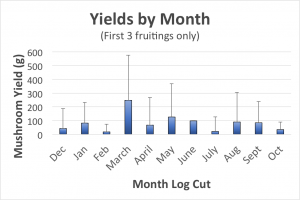
Figure 1. Average shiitake mushroom yields (g/log) at Field & Forest Products from first three fruitings on logs cut each month (Dec (N=20), Jan (N=22), Feb (N=23), March (N=26), April (N=23), May (N=27), June (N=20), July (N=25), August (N=21), September (N=22), October (N=20)).

Figure 2. Relationship between bark thickness (thin/smooth, medium, thick/coarsely furrowed) and log diameter in Red Maple shiitake cultivation logs.
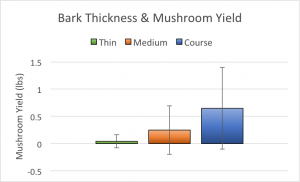
Figure 3. Relationship between bark thickness (thin/smooth, medium, thick/coarsely furrowed) and average mushroom yields per Red Maple shiitake cultivation log.
|
Table 1. Percent of total logs by month cut that never produced shiitake mushrooms (Non-Producing Logs). # Logs |
# Non-Producing Logs |
% Non-Producing Logs |
|
|
Dec |
20 |
18 |
90 |
|
Jan |
22 |
15 |
68 |
|
Feb |
23 |
17 |
74 |
|
March |
26 |
8 |
31 |
|
April |
23 |
17 |
74 |
|
May |
27 |
14 |
52 |
|
June |
20 |
8 |
40 |
|
July |
25 |
24 |
96 |
|
Aug |
21 |
17 |
81 |
|
Sept |
22 |
15 |
68 |
|
Oct |
20 |
12 |
60 |
Table 1. Percent of total logs by month cut that never produced shiitake mushrooms (Non-Producing Logs).
|
% non producing Logs |
# non-producing Logs |
# non producing |
|
|
Fall Red Maple |
0% |
0 |
25 |
|
Spring Red Maple |
8% |
2 |
25 |
|
All Wood Species Inoculated |
16% |
28 |
175 |
|
All Wood Excluding Hickory * *Hickory took 18 months to fruit so only stated to produce at end of the project. |
7% |
12 |
175 |
Table 2. Misty Dawn Farm - Percent of logs that did not produce during the study
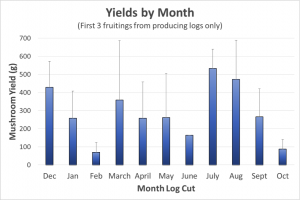
Figure 4. Average shiitake mushroom yields (g/log) from mushroom producing logs only at FFP from first three fruitings on logs cut each month (Dec (N=2), Jan (N=7), Feb (N=6), March (N=18), April (N=6), May (N=13), June (N=12), July (N=1), August (N=4), September (N=7), October (N=8)).
|
Month |
Total logs |
Removed logs |
Removal % |
|
Dec ‘14 |
20 |
10 |
50 |
|
Jan ‘15 |
22 |
6 |
27 |
|
Feb ‘15 |
23 |
14 |
61 |
|
March ‘15 |
26 |
8 |
31 |
|
Apr ‘15 |
23 |
7 |
30 |
|
May ‘15 |
27 |
17 |
63 |
|
Jun ‘15 |
20 |
12 |
60 |
|
Jul ‘15 |
25 |
3 |
12 |
|
Aug ‘15 |
21 |
7 |
33 |
|
Sept ‘15 |
22 |
0 |
0 |
|
Oct ‘15 |
20 |
0 |
0 |
Table 3. Percent of total logs by month cut that had to be removed prematurely from the study due to disease presence and premature bark loss as of January 20th, 2017. Younger logs from September and October were less likely to show signs of disease at this time. Diseases included slime molds (E.g. Stemonitis fusca, Fuligo septica), and carbon balls (Daldinia concentrica).
Objective 2 - Determine whether time between felling and inoculation influences mushroom productivity
Average shiitake mushroom yields for logs at FFP cut in December and rested 20 weeks prior to inoculation in April (Dec/April) were marginally statistically significantly more productive (118g) than logs cut in December (43g) and April (68g) and immediately inoculated 2 weeks later (F = 2.9, p = 0.066) (Figure 5).
Average shiitake mushroom yields for logs at MDF cut in December 2014 (Dec) were marginally statistically significantly less productive (322g) than logs cut in the following February 2015 (464g) (F = 3.3, p = 0.076) (Figure 6). December cut logs rested 25 weeks whereas February cut logs rested 14 weeks prior to all logs being inoculated in May 2015. Disease presence was significantly higher in the Red Maple logs compared to other wood species (Red Oak, White Oak, Sugar Maple, and Aspen) managed similarly (Rae West, personal communication).
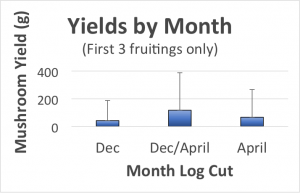
Figure 5. Average shiitake mushroom yields (g/log) at FFP based on the first three fruitings of only successful mushroom producing logs cut in December and inoculated 2 weeks later (Dec), logs cut in December and inoculated 20 weeks later in April (Dec/April), and logs cut in April and inoculated 2 weeks later (April).
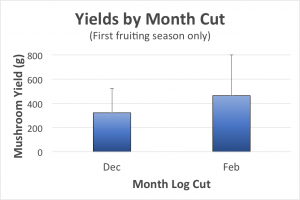
Figure 6. Average shiitake mushroom yields (g/log) at MDF based on the first season of fruiting. December 2014 cut logs (Dec, N=25) were cut and rested 25 weeks prior to inoculation and February 2015 logs (Feb, N=25) were cut and rested 14 weeks prior to inoculation.
Objective 3 - Determine viability of Red Maple logs as a commercial shiitake mushroom substrate by measuring:
- Mushroom productivity
- Log longevity
- Disease problems
- Log parameters
Of the 265 logs managed at FFP, 21 logs (8%) yielded over 1.0lbs mushrooms, and 2 logs (<1% total logs) yielded over 2lbs of mushrooms in the first three fruitings. The most productive log in this study was a March cut log that yielded 1048g in the first three fruitings.
Of the 50 logs managed at MDF, 19 logs (38%) yielded over 1.0lbs (454g), and 4 logs yielded over 2.0lbs (908g) of mushrooms in the first season of fruiting. The most productive log was a February 2015 cut log that yielded 1040g. All logs at this location remain viable and will continue fruiting in 2017.
Average yields per log from other wood types during this study include Sugar Maple (310g), Red Oak (438g), White Oak (460g), Aspen (406g), and are comparable to Red Maple cut in December (363g) and Red Maple cut in February (464g) (Figure 7).
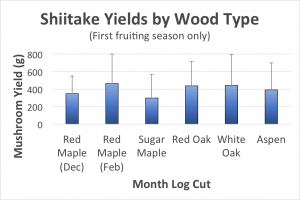
Figure 7. Average shiitake mushroom yield (g/log) across a variety wood types (N = 25 each). Some Red Maple logs were cut in December (Dec) while others were cut in February (Feb). All logs were inoculated spring 2015. Yields were taken over the first fruiting season, 2016.
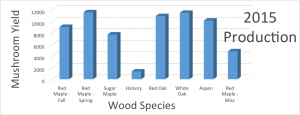
Figure 8. Misty Dawn Farm production for the total 2015 season. Shiitake mushroom yields (g) from Red maple logs cut in December N=25 and in February N=25. Plus Fall Harvest Sugar Maple (N=25) Hickory (N=25) Red Oak (N=25) White Oak (N=25) Aspen (N=25) Red maple Misc indicates Red Maple inoculated with other strains of shiitake mushrooms.
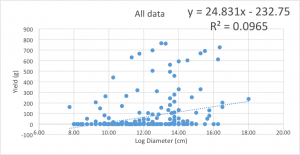
Figure 9. FFP Log Size Compared to Yield
DISCUSSION
Objective 1 - Assess the effect of log fell timing throughout the year on mushroom productivity
In looking at the effect of month cut on shiitake log success, March logs cut during sap flow were highest yielding. December and February cut logs were among those that yielded the lowest. This is contrary to popular opinion that logs should be cut during the dormant season from leaf color change in the fall up until bud swell in the spring. It is said that logs cut during the dormant season have better bark retention and hence log longevity and overall production performance. In terms of performance, the overall average yields from logs at FFP were extremely low compared to standard shiitake log cultivation. There was a very low success rate in logs that ever produced mushrooms. Standard shiitake cultivation practices usually result in a success rate of ~98.5%, meaning of 50 logs inoculated, typically only a single log never produces mushrooms. The number of logs that never produced mushrooms “non-producing logs” was very high and significantly influenced average yield per log results. This log failure can be due to any of a multitude of reasons like log moisture loss, presence of competing disease, and log revitalization.
In this part of the study, we attempted to control log moisture by keeping logs in a higher than normal humidity environment as well as account for differences in natural moisture loss due to log parameters like diameter and bark thickness. Based on the data collected, log diameter and bark thickness were significantly related to mushroom yield. This is intuitive because larger logs and those with thicker bark are better at moisture retention and less prone to drying out, which is directly related to shiitake cultivation success. Even bearing this in mind, the overall low success rate of the logs cannot be explained by these variables.
We monitored logs for disease presence and culled logs that were infected with highly communicable contaminants (e.g. slime molds) per standard shiitake cultivation practices.
Lastly, contamination by other fungi was also problematic in this study. Slime molds such as Stemonitis fusca and Fuligo septica are particularly aggressive and can easily spread to nearby logs. For this reason, heavily contaminated logs were prematurely removed from the study. Other diseases present included carbon balls (Daldinia concentrica) and superficial contaminants like green molds. It would seem that contamination presence in the Red Maple logs was higher than in other wood types like Oak used in standard shiitake cultivation. This may have something to do with the diffuse-porous structure of Red Maple wood versus the ring-porous nature of Oak, but there is not much research on this topic.
Standard shiitake cultivation technique states that logs cut should rest for 2 weeks minimum prior to inoculation. This time allows for cellular dieback in the log and subsequent dampening of the log’s defense system against fungal invasion. Shiitake is a saprophytic fungus that invades and consumes dead organic matter. In the case of this study, the two week rest period between cutting and inoculating was insufficient and some of the red maple logs showed signs of revitalization (lack of spawn run, spawn compartmentalizing near the inoculation point, and log sprouting (Figure 8).
Objective 2 - Determine whether time between felling and inoculation influences mushroom productivity
Logs from FFP had a very low success rate likely due to log revitalization. This indicates that 2 weeks resting period between log felling and inoculation is insufficient. This hypothesis is supported by the difference in mushroom productivity measured between logs cut in December that were either inoculated 2 weeks after cutting and logs inoculated 20 weeks after cutting. Logs allowed to rest 18 weeks longer prior to inoculation were more successful and productive. This is also supported by the significantly higher success rate of mushroom producing logs at MDF over FFP, although direct comparisons between the two farms cannot be made due to differences in log management and timing.
The results of the study highlights a need for future research investigating the minimal rest time needed from log cut to inoculation necessary for shiitake cultivation success.
Objective 3 - Determine viability of Red Maple logs as a commercial shiitake mushroom substrate by measuring:
- Mushroom productivity
- Log longevity
- Disease problems
- Log parameters
Expected average yields from standard shiitake production on logs is approximately 1.0-2.5lbs (454-1135g) per log from the first three fruitings (Joe Krawczyk, personal communication). Using this 1.0lb minimum yield in the first growing season as a measure of success, only 8% of the logs managed at FFP and 38% of logs managed at MDF were deemed successful by commercial standards. However, this study uncovered variables that influenced shiitake success on Red Maple. By selecting for log parameters (coarse bark, >5.5”/14cm diameter), allowing sufficient rest time between felling and inoculation, and controlling for competing fungal disease, red maple logs are capable of producing yields comparable to other wood species commonly used in commercial cultivation of shiitake such as Sugar Maple and Oak species.
As a business, the results of this grant allow us to better answer customer questions regarding wood suitability for mushroom cultivation and make recommendations for those choosing to use Red Maple as a substrate. As growers, we can continue to investigate the variables unanswered in this study while utilizing a readily available, low-cost wood source. There are abundant advantages to being able to utilize Red Maple over standard wood species including cost per log ($2.00 versus $3.00, respectively), increased availability and abundance, increased speed of stand regeneration after wood harvest, and public willingness to harvest weedy wood species.
Additional Observations
- Smaller diameter logs have a shorter spawn run duration than larger logs.
- Softer wood species have a shorter spawn run duration than harder wood species. Making them a good addition to a beginning farmer’s production schedule. Since they will be able to harvest mushrooms sooner than on the longer spawn run hardwoods. This could give the mushroom farmer an additional season of production.
- For a small-scale farmer like MDF, inoculation often spans over several months. This allows for good incorporation of woods that have a long revitalization time frame. Hardwoods should be inoculated first in the inoculation schedule to give them a longer incubation period, this should be followed by softer woods such as Red Maple and Aspen. This provides the farmer a longer growing season for the hardwoods while ensuring interim mushroom production on the soft woods.
- Small scale farmers like MDF currently only have ability to soak smaller quantities of logs 10 -20 logs per day/50-100 per week max. This spreads out the harvest over a longer period of time and allows the logs a chance to rest.
- We found the average larger size of the Night Velvet on soft wood of the mushrooms affects efficiency of harvest. These larger mushrooms were also more coveted by customers over smaller varieties. The largest mushroom harvested was 9 inches in diameter. Most restaurants preferred a mushroom in the 4-6 inch size range. They are easier to process. Antidotal observation: the Night Velvet strain on Red Maple consistently produced larger mushrooms. This was not tracked in the study
- Percent of logs with no production and the long revitalization time on the red maple indicates that it should sit for a longer period of time to make sure inoculated spawn will not be rejected by the logs immunity. If we were to do the study again FFP would do the cuttings again the same as before but would let logs sit for a longer duration to see what the optimal time would be to inoculate.
- In this study we looked at the use of Red Maple as a substrate however, we did not look at the relationship of the frequency of forcing and harvesting or the longevity of the logs as a substrate for fruiting. These would all be ideas for further study.
- Based on the work this grant funded, we can conclude that Red Maple is a potentially viable substrate for shiitake cultivation on logs. We discovered that larger diameter, coarser-barked logs are more productive than smaller diameter, smooth-barked logs. We also determined that a rest time of 2 weeks from felling to inoculation is not sufficient for optimal shiitake colonization and subsequent fruiting success. Logs that were rested greater than 14 weeks prior to inoculation were significantly more successful and produced higher yields. While taking these caveats into consideration, Red Maple logs are capable of producing yields comparable to other wood species commonly used in commercial cultivation of shiitake such as Sugar Maple and Oak species.
- Given that log revitalization was a problem in this study, a valuable continuation of this research topic would be to assess the optimal duration from log cut to inoculation for wood types prone to revitalization.
PROJECT IMPACTS
Due to the long viability of logs as a mushroom substrate (2-5 years) economic data could not be calculated for this project.
OUTREACH
Information from this study has been shared through a wide variety of venues reaching over 500 people and counting. Preliminary results were presented at the MOSES Organic Farming Conference in La Crosse, WI reaching approximately 300 attendees. Furthermore, the viability of Red Maple as a substrate has been discussed with participants at inoculation events and workshops held thus far and in the future at FFP and MDF reaching over 150 individuals.
Because of the nature of this continuing research, we are waiting on producing the final and complete copy of the brochure until the additional supplemental data can be collected and analyzed on log longevity and the economic costs associated with using Red Maple versus hardwoods. Once printed, the brochure will be distributed at trade shows and conferences in 2018 and beyond by SHIIGAW and FFP. This final report and future supplemental research will be posted on the SHIIGAW, WWOA, and FFP website, including a featured blog, “The viability of Red Maple for shiitake production”. FFP along with SHIIGAW members, provide information and guidance to mushroom growers and form an extensive, far reaching network of communication over which the results of this study have been shared since late 2015. Those reached, including Cornell’s Small Farms Program, Missouri Agroforestry Center, and Northeast Forest Mushroom Growers Network, have been very receptive to the possibility of using Red Maple for shiitake production.
PROGRAM EVALUATION
We found the project to be a very positive experience and feel that the program gave us an excellent opportunity to collect valuable information and data. Having multiple farmers involved was a great way to increase the potential outcomes of the study and showed us some flaws in our research variables that we hope to address by continuing the research in the coming year. We expect to file a follow up to our grant report with this data in 2019.